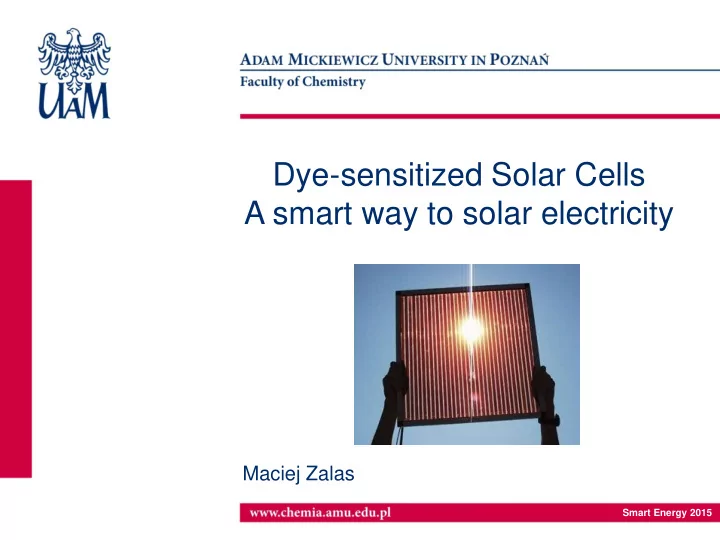

Dye-sensitized Solar Cells A smart way to solar electricity Maciej Zalas Smart Energy 2015
Civilization = Energy Consumption Energy – The ability to perform work www.financialsense.com/ Smart Energy 2015
Energy Sources oscareducation.blogspot.it Smart Energy 2015
Sun Energy consumption of the planet Earth: Flora 1 10 14 W/Year Humankind 1.3 10 13 W/Year (2000) Humankind 2.8 10 13 W/Year (2050) Difference: 1.69872 10 17 W/Year http://goaskgrandpa.com Energy supply = 1.7 10 17 W/Year Smart Energy 2015
Photovoltaics – The Beginning http://www.rats-ms.de http://www.solartec.lu Alexandre Edmond Becquerel 1839 – Photoelectric effect on Pt 1820 - 1891 electrodes covered by AgCl or AgBr Smart Energy 2015
A bit of History 1883 – Charles Fritts described the first solar cell made from selenium wafers. 1905 – Albert Einstein published his description of the phenomenon of the photoelectric effect (Nobel Prize 1921) 1941 – Russell Shoemaker Ohl patented first silicon solar cell ( h = 1 %) 1954 – First commercial solar cell introduced on the market by Bell Telephone Laboratories ( h = 6 %) 1958 – NASA launched first solar cells powered artificial satellite Vanguard I 1976 – David Carlson and Christopher Wronski produced the first amorphous silicon photovoltaic cell ( h = 1.1 %) 1991 – Brian O’Regan and Michael Gr ä tzel invented the first high effective Dye-sensitized Solar Cell ( h = 7.8 %) Smart Energy 2015
Photovoltaics – Efficiencies by EPFL Smart Energy 2015
Dye-sensitized Solar Cells Medium or low-purity materials Simple preparation methods Relatively good efficiencies (recent record h = 14.1 % acc. EPFL) Low costs www.solarisnano.com Smart Energy 2015
DSSC – How it works? Smart Energy 2015
Dye-sensitized Solar Cell Anode: Conducting glass covered by semiconducting oxide sensitized by dye molecules Electrolyte: solution of redox mediator Cathode: Conducting glass covered by redox catalyst K. C. D. Robson , P. G. Bomben, C. P. Berlinguette Dalton Trans., 2012, 41, 7814-7829 Smart Energy 2015
Semiconductor – Key to Success Smooth surface; low surface area Low dye adsorption Low light harvesting Poor efficiencies ( h < 1 %) Smart Energy 2015
Semiconductor – Key to Success High surface area 1000 times higher dye adsorption High light harvesting Good efficiencies ( h > 10 %) Smart Energy 2015
Dye-sensitized Solar Cell Anode: Conducting glass covered by semiconducting oxide sensitized by dye molecules Electrolyte: solution of redox mediator Cathode: Conducting glass covered by redox catalyst K. C. D. Robson , P. G. Bomben, C. P. Berlinguette Dalton Trans., 2012, 41, 7814-7829 Smart Energy 2015
Dye – Heart of the System Natural dyes (Anthocyanines, Carotenoides, etc.) Very broad and strong absorption of Vis light Cheap and available (crude form) Poor stability (oxidation sensitive) Smart Energy 2015
Dye – Heart of the System Ruthenium dyes Broad and strong absorption of Vis light High stability in the cell conditions Strong binding to the semiconductor surface Adequate reduction and oxidation potentials Long term living excited state Expensive Smart Energy 2015
Dye – Heart of the System Synthetic organic dyes Tunable absorption of Vis light High stability in the cell conditions Strong binding to the semiconductor surface Adequate reduction and oxidation potentials Short term living excited state Tunable structure, synthesis and price Smart Energy 2015
Dye-sensitized Solar Cell Anode: Conducting glass covered by semiconducting oxide sensitized by dye molecules Electrolyte: solution of redox mediator Cathode: Conducting glass covered by redox catalyst K. C. D. Robson , P. G. Bomben, C. P. Berlinguette Dalton Trans., 2012, 41, 7814-7829 Smart Energy 2015
Electrolyte – Binding Element Iodine/Iodide electrolytes Corrosive towards metals and ”multiple bonds” Adsorbs light towards blue part of the spectrum Redox potential limiting V oc to 0.7-0.8 V Two electron redox mechanism K. C. D. Robson , P. G. Bomben, C. P. Berlinguette Dalton Trans., 2012, 41, 7814-7829 Smart Energy 2015
Electrolyte – Binding Element Noncorrosive Low absorption in visible region Facile tuning of redox potential One electron redox mechanism Smart Energy 2015
Dye-sensitized Solar Cell Anode: Conducting glass covered by semiconducting oxide sensitized by dye molecules Electrolyte: solution of redox mediator Cathode: Conducting glass covered by redox catalyst K. C. D. Robson , P. G. Bomben, C. P. Berlinguette Dalton Trans., 2012, 41, 7814-7829 Smart Energy 2015
Counter Electrode – Last but not Least Best known redox catalyst Completely stable Easy to prepare electrodes Very expensive www.periodictable.com Smart Energy 2015
Counter Electrode – Last but not Least Carbon electrodes Low charge transfer resistance High surface area Low costs Efficiencies comparable to Pt Relatively poor stability http://cnx.org Smart Energy 2015
Solar Cells – Characterization P J V d J V h max max 100 % P Light J V max max FF 100 % J V sc oc J V FF h sc oc P Light Smart Energy 2015
Thank You for Attention Smart Energy 2015
Recommend
More recommend